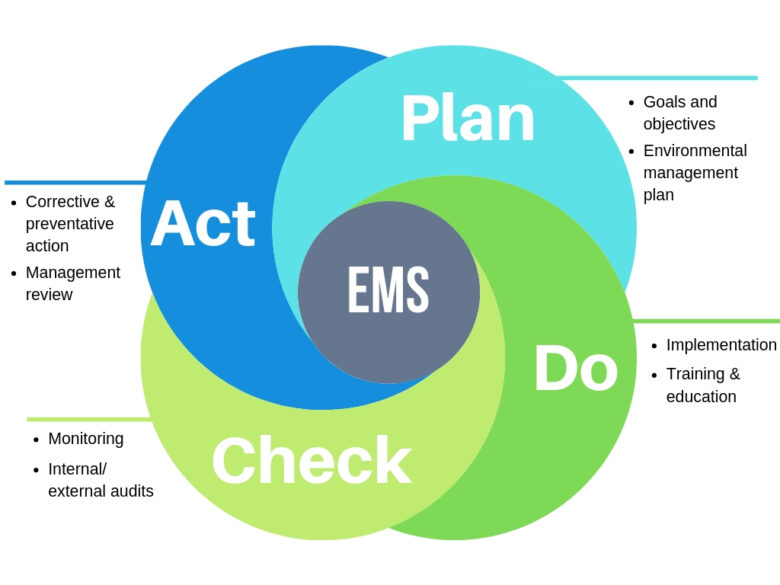An Environmental Management System (EMS) is more than just a mere set of guidelines. It is a comprehensive structure used by organizations to meet the rising demands of environmental conservation.
These systems allow organizations to harness their full potential in an eco-friendly manner, ensuring both sustainability and business growth.
This article will guide readers through the crucial steps for implementing an EMS, emphasizing its importance in today’s ecologically-conscious business landscape.
Contents
- Understanding the Benefits of EMS
- Setting Clear Environmental Objectives
- Conducting a Comprehensive Environmental Review
- Compliance with Environmental Regulations
- Engaging Stakeholders
- Developing an EMS Plan
- Implementing Sustainable Practices
- Monitoring and Measuring Progress
- Employee Training and Awareness
- Review and Improvement
- Conclusion and Future Sustainability
Understanding the Benefits of EMS
When we discuss EMS, the advantages are manifold, spanning both environmental and business domains. At its core, an EMS promotes a symbiotic relationship between an organization and the environment. By adhering to an EMS framework, organizations can drastically cut down their carbon emissions, leading to a palpable positive impact on our planet.
Moreover, the financial benefits cannot be overlooked. Adopting eco-friendly measures invariably leads to reduced operational costs, and given today’s consumer preference for sustainable businesses, it can enhance market positioning.
For instance, the globally recognized ABC Corporation documented a significant reduction in its operational costs, attributing a 25% savings directly to EMS practices.
Another noteworthy example is XYZ Corporation, which managed to reduce its carbon emissions by an impressive 30% within just five years of EMS implementation. Beyond the palpable benefits, an EMS elevates a brand’s reputation, resulting in customer loyalty, attracting investors, and ensuring long-term profitability.
Setting Clear Environmental Objectives

Source: shrm.org
Laying out an effective EMS requires a strategic vision. Clear, actionable environmental objectives set the direction for this vision as you’ll see if you click here. The importance of these objectives cannot be stressed enough. They bridge the gap between lofty ideals and actionable tasks.
An organization’s environmental objectives should be in harmony with its overarching mission and business goals. For instance, if a company’s mission is to provide eco-friendly products, a measurable objective might be to source 80% of raw materials sustainably by the end of a fiscal year.
Such targets act as a motivating force, propelling organizations towards ecological responsibility. Furthermore, having tangible environmental goals fosters trust among stakeholders, assuring them that the company is committed to making a real-world difference.
Conducting a Comprehensive Environmental Review
Before diving headfirst into EMS implementation, it’s imperative to gauge where you currently stand. An environmental review acts as a diagnostic tool, identifying both strengths and areas of improvement.
This involves data collection, allowing a company to measure its existing environmental impact in areas like water usage, waste generation, and energy consumption.
Modern tools, like Environmental Impact Assessment (EIA) software, can assist organizations in this meticulous review process, highlighting areas needing immediate attention and providing a foundation to build their EMS.
Compliance with Environmental Regulations

Source: insights.tetakawi.com
Sailing the eco-friendly path isn’t just about goodwill; it’s a legal necessity. Regulations exist at multiple levels, from local zoning laws to international treaties.
To seamlessly integrate an EMS, understanding these regulations is pivotal. However, this isn’t a one-time task. With the dynamic nature of environmental issues, these regulations often evolve.
Regular monitoring ensures that an organization remains compliant. Ignoring this can have dire consequences, ranging from financial penalties to reputational damage.
Engaging Stakeholders
EMS is a collective endeavor. While leadership plays a pivotal role, stakeholders at every level – be it employees, customers, or suppliers – influence its success. Each stakeholder brings a unique perspective, making their involvement invaluable.
For instance, employees can provide insights into daily operational inefficiencies, while customers might offer feedback on product sustainability. Communication is key. Regular forums, surveys, or focus groups can ensure that all voices are heard, fostering an inclusive EMS environment.
Developing an EMS Plan

Source: supplychainschool.co.uk
An EMS plan serves as the backbone for all environmental endeavors within an organization. It’s a comprehensive document detailing policies, procedures, and protocols for achieving set environmental objectives. Start with a clear policy statement, reflecting the organization’s commitment to environmental stewardship.
Follow this with actionable steps, clearly defined roles, and responsibilities. For instance, a manufacturing unit might have procedures for waste reduction and energy consumption, with specific department heads accountable for each.
Maintaining a clear, accessible document is pivotal, as it not only guides internal operations but also instills confidence among external stakeholders. Look to industry best practices or ISO 14001 standards as blueprints when crafting your plan.
Implementing Sustainable Practices
Transitioning to sustainable practices is more than just a trend; it’s a necessity. Every aspect of operations offers an opportunity for eco-friendly optimization. In energy consumption, for instance, consider transitioning to renewable sources or enhancing energy efficiency through better insulation and equipment.
Waste reduction can be tackled with robust recycling programs and a move towards circular economy principles. Water conservation, sustainable sourcing, and green transportation are other areas ripe for transformation.
One inspiring success story is Company DEF, which shifted to solar energy, reducing its carbon footprint and energy costs by 40% within two years. Emulating such examples can pave the way for greener business operations.
Monitoring and Measuring Progress

Source: apartmenttherapy.com
An EMS is not a “set and forget” system. Constant monitoring ensures its efficiency. Establishing key performance indicators (KPIs) is crucial. These could range from metrics like ‘liters of water used per product unit’ to ‘percentage of recycled waste’.
Modern tools and software, such as Environmental Management Information Systems (EMIS), can streamline data collection and analysis. Regular audits, both internal and third-party, can also provide invaluable insights, ensuring the organization remains on the eco-righteous path.
Employee Training and Awareness
Employees are the lifeblood of any EMS. Their daily actions influence its success. Thus, investing in thorough training programs is imperative. From understanding the nuances of the EMS plan to hands-on training in sustainable practices, such sessions foster a culture of sustainability.
Beyond structured training, creating an environment where eco-awareness is second nature is beneficial. Simple initiatives, like celebrating ‘Green Days’ or regular environmental quizzes, can keep the flame of eco-consciousness alive and burning.
Review and Improvement

Source: engineering.fb.com
Continuous improvement is a cornerstone of EMS. Regular reviews allow organizations to gauge their progress and identify areas ripe for enhancement. The Plan-Do-Check-Act (PDCA) cycle is a renowned methodology in this domain.
After planning and implementing (Plan & Do), the organization reviews the outcomes (Check), and then refines its strategies accordingly (Act). This cyclical process ensures that the EMS remains dynamic, evolving in response to both internal and external changes.
Conclusion and Future Sustainability
Within this journey, understanding the core principles of reducing, reusing, and recycling is fundamental. To dive deeper into this approach, consider exploring our guide on embracing sustainable habits.
In summary, implementing a successful EMS is a holistic journey, requiring vision, dedication, and continuous effort. As we stand at the crossroads of business and the environment, it’s evident that sustainability isn’t just a passing phase but a core business principle.
Organizations must stay abreast of emerging eco-friendly technologies and trends, ensuring they remain at the forefront of environmental stewardship.
As the legendary environmentalist, Rachel Carson said, “The human race is challenged more than ever before to demonstrate our mastery, not over nature but of ourselves.” It’s high time we heed this call, and EMS is our roadmap to this sustainable future.
